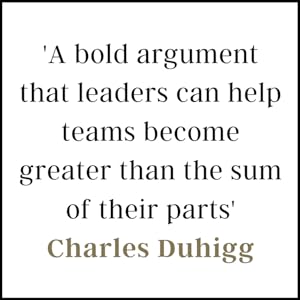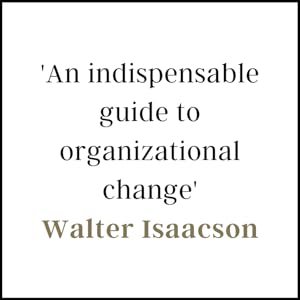

Full description not available







M**N
Turning abstract ideas into real solutions
I first heard of Team of Teams back in 2019 when I attended a meeting hosted by thought leader Gene Kim in which he mentioned General Stanley McChrystal's work. Since then, I have listened to many podcasts, webinars and conference talks in which this book is referenced. As a result, I felt I needed to read it! I am glad I did!What I find most appealing about Team of Teams is that McChrystal has written about how he changed a large organisation to adapt to a new threat that traditional structures were unable to tackle. Taking this experience and documenting it in an easy-to-read and engaging thesis takes the reader on a journey of change based on real events that put theory into practice with dramatic positive outcomes.If you are serious about addressing problems associated with ancient institutional structures that limit the capacity for your organisation to adapt to the more complex environments in which it functions, then this book helps you understand why change is necessary and offers a blueprint of how that change should look.Some of the ideals of DevOps are based on the ideas that are explained in this book, such as organisations promoting psychological safety as well as building teams and communication that emphasise locality and simplicity. For me, this book gave me those 'aha' moments when abstract concepts become crystal clear actions in my own mind.I also read this book in short time owing to the engaging way it is written. I have dog-eared many pages for reference and so will return to this book over and over as I continue along my own journey.
B**A
Team of Yeams
A good read
A**N
Wall St know-how applied to the War on Terror
This is the story of how General Stanley McChrystal brought Wall Street trading floor working practices (which have existed for decades) to the battlefield in Iraq.The general implemented the trading floor business model on the battlefield in Iraq because he had to. When you have to respond to a distributed network of terrorists (or are put in a "winner's curse" competition with other dealers to buy or sell a bond) you cannot plan your reaction. Either there’s somebody ready to be deployed in the field who can react in real time and feed back all intelligence in real time to other assets in the battlefield (marketplace) who will act upon it in real time, or you may as well give up. McChrystal woke up to the fact that he was facing complexity every bit as much as a trading floor does that’s pricing tens of deals for tens of types of customers at the same time and that the top-down structure was not fit for purpose in Iraq.No matter how strong his navy SEALS or Army Special Forces were, “whatever efficiency is gained through silos is outweighed by the costs of interface failures.” (p. 151) In his words (p. 74), “unpredictability is fundamentally incompatible with reductionist managerial models based around planning and prediction.” To defeat Al Qaeda in Iraq, the military would have to move from “doing things right” to “doing the right thing.” This was not going to be about refining a process down to the last detail, but about having the right people in the right place armed with the right information and letting them figure it out.I’ve spent more than twenty years on trading floors, here’s how it all works:Each desk is comprised of three to eight traders who know each other well, have worked together for years and trust each other blindly. Each trader specializes in a very narrow set of securities or derivatives he knows inside out and each can count on his buddies to cover for him out of his own book when the circumstances dictate he should.There’s as many desks as there are products to trade. The desks acknowledge each other and work together seamlessly to do transactions that cut across more than one specialties.Example: Suppose a new issue needs to be brought to market. The syndicate desk will act as the new bond’s midwife, guiding the issuer as to the best pricing and timing and carries the eventual risk of any unplaced bonds on its books. The syndicate desk can count 100% on multiple sales desks to place the new issue and it can count 100% on the swaps desk to take away all market-directional risk the client would otherwise bear. The swaps desk, in turn, can 100% count on immediate execution of bond and futures hedges from seamlessly (often electronically) connected bond and bond futures desks. Everybody sits in one room and within earshot of each other. Everybody is part of a small desk, but there are unofficial, unwritten and constantly revised protocols for how the desks will interact.There is a morning meeting for the whole trading floor (with participation from Japan), delivered over the stentor and another global (that means London and New York) meeting at seven thirty New York time. The economist speaks and previews today’s data, all desk representatives speak in a formal order to discuss new supply (auctions or syndications), market trends, the biggest flows and where they reckon the market is going. This is called “market color.” The sales desks follow with the most important business from the day before and any important transactions that are coming up. Everybody knows what’s coming and how it fits together. Everybody can interrupt the meeting, more than a thousand people. The Monday morning meeting is typically done out of New York. Sometimes a high-up guy attends and addresses the troops, and this is done in an auditorium and is fed through to the stentor for those who are on their desks.The heads of desk all meet regularly with one another and with the head of the entire trading floor, both formally and informally. There is tension between the sales desks and the trading desks, because the sales desks mainly get compensated for volume. No good way has been invented to measure the profitability of trades, but it’s plenty easy to see if the competition is doing the business and business does not much happen in the absence of profit.Senior management merely choreographs these interactions. It fosters exchange of information, listens to the salesforce to find out what the customers are doing and to the best traders to find out how it all makes sense. Eyes on, but hands off.All decisions are made in real time by the most junior person on the floor who is qualified to make them. Management’s role is to stop him out if he’s losing, give him more rope to hang himself if he’s winning and compensate him, promote him or fire him at yearend based on an assessment of his performance. Management manages people, not individual trading decisions. If a trade is big enough that management finds out about it, you really should consider passing on it and there had better be some awesome outside PR benefits to winning it.The model is very much a “team of teams.”So General McChrystal had the epiphany that his team would have to abandon the command-and-control structure and morph into a network. A network that would be just as networked as Al Qaeda’s, but, better. He visited Michael Bloomberg, a former Salomon Brothers trader, head of technology at Salomon and eventually founder of a trading systems empire and got the blueprint. He put together the whole thing, soup to nuts:1, he recognized that every attack would be different2. he anticipated that solutions would have to come out of a bottom-up result of interactions, much like Al Qaeda’s3. he decided to emphasize connectivity and trust over reductionist precision4. he recognized that there would be efficiency costs to this approach and was prepared to take the associated criticismHe did not start from scratch. He already had some amazing teams under his command. Navy SEALs, Army Special Forces, intel analysts, all had solid, tightly knit, professional and highly trained teams going, but the task was to make them work together (though I don’t think the word “Marines” comes up once if you do a word search; we all have our prejudices).Job #1 was to create a “shared consciousness” and he did it exactly how you’d do it on a trading floor, using communication protocols that were first established by NASA to launch the Apollo project. He got himself a massive space and turned it into what Stanley Kubrick would call a “war room.” He ran out of there daily one-hour long meetings that he chaired himself, inviting everybody to the table. Not only all three forces, but also the CIA, intelligence, airpower controllers, medical staff, everyone. He covered the walls with screens bringing back footage from ongoing raids, logs of captures, maps of recent gains and losses, casualties etc. and made the room the permanent office for himself and his top lieutenants, with people arranged to sit in a U around them. No cubicles, no special room for General McChrystal.The point was that anyone in the room could have the latest information, pretty much at the same time as his or her commanding officers. Takeup was far from immediate. Lots of the seats were initially left empty. But over time, this became the place you had to be, because that became the best way to be current. Eventually everybody joined, including the Intelligence folks, as the process “developed its own gravitational pull” and “the information shared was so rich, so timely, and so pertinent to the fight, no one wanted to miss it.” (p. 168)Job #2 was to build trust between the teams he commanded. “Each agency feared that sharing intelligence would work against its own interests. Competition between agencies made them reluctant to provide information; what if a partner agency did not reciprocate?” To get there, he instituted an embedding program, whereby he forced teams to send some of their best players to go work with other teams. “If you won’t miss him, don’t send him” was the rule. Often these people would be given menial tasks by their host teams, but because they had been carefully selected they invariably ended up having a lot to offer. And over time, not a long time, connections of trust between the teams were formed around the embedded emissaries. Everybody at every team could say with no exaggeration that he knew and trusted somebody in each of the other teams.And that’s how the structure came about of a “team of teams” with “shared consciousness,” a shared purpose and widely shared information who could act as one.Soon enough, the results started coming in. The number of raids the team could successfully execute leapt by an order of magnitude. And previously unheard of stuff like follow-on targets became a daily reality. But also treason, as megabytes and megabytes of information found its way onto Wikileaks. General McChrystal does not dwell too long on the Bradley Manning affair, but it has to be recognized as a downside of the approach he took. On the other hand, he did get Zarqawi and he makes the case very persuasively he never would have without applying his method.The biggest epiphany he had though, was to do with his own role. Once the team of teams was up-and-running, he realised his authority to order raids was actually in everybody’s way.Job #3 became to redefine his job. He had to let go. “The wait for my approval was not resulting in any better decisions, and our priority should be reaching the best possible decision that could be made in a time frame that allowed it to be relevant.” So he reluctantly devolved his powers to sanction raids to the lowest operative who could reasonably expected to make the decision. The thinking was that the extra speed would compensate for the possibly inferior decision making. He was in for a surprise. The empowered and informed leaders in the field actually obtained better, more precise results than they’d done before, when he’d been masterminding the attacks. He thought he’d give something up to gain something more important. He actually got both.And thus he realised that he’d have to redefine his job. Yes, he’d have to keep his eyes on the ball. But he’d have to keep his hands off. From the heroic leader / chessmaster he had been trained to be and had dreamt of becoming one day, he had already morphed into a gardener, a man who keeps the correct environment going and merely tends to his garden while allowing nature to take its course.Which neatly brings me back to the trading floor and the world of investment banking.The head of the trading floor knows everything, but never has to give an order. He lets traders do their thing. His decisions revolve around personnel, the overall direction of the business, and the allocation of resources, most important of which is compensation.Thing is, when something wrong happens it is nigh-on impossible to pin it on himlAnd so it came to pass that the highest-ranking person who will go to jail for the LIBOR scandal will probably be a 34 year old Aspergers sufferer called Tom Hayes. Legend has it the man sleeps in a Spiderman duvet. Leaving to one side the question of whether he was doing anything wrong (my personal view is nothing in principle, but plenty in the detail) he's finding it very difficult to prove he was acting on the orders of his superiors. But of course the law knows how to follow the money and fully realises he was.And what does the law do?Ah, that's the fun bit. It's forcing trading floors across London, Tokyo and New York to abandon the "team of teams" structure they passed on to General McChrystal and is demanding that all banks provide full top-down organograms, of the kind that will allow orders to flow downward and blame upward. And it's forcing banks to hire thousands and thousands of lawyers to ensure they comply with the new structure.Not only that. Additionally, the regulators are forcing trading operations to ban mobile communications, Twitter, social media etc. from trading floors, while teams of lawyers are trolling over all Bloomberg chats from the past ten years, making any and all communication dangerous, in case it's taken out of context. What's the result? When once traders, with their access to Reuters, Bloomberg, TV channels and multiple chats once stood in the center of the information flow, they now find themselves the most isolated from the real world they've ever been. Instead of sitting in the middle of a communication hub, they need to wait till they've gone home to find out from their spouse what happened today in the world.What will come of it? Very simple. First, those organizations and individuals who have alternatives will exit the business and focus on more profitable stuff, driving prices wider. That's only the beginning. Prices will have to widen even further, to accommodate the fact that the wrong business structure will result in a blunter, slower, defensive response to the better networked, sharper, customer enquiry. Finally, somebody will have to pay for the thousands and thousands of compliance officers, and that's the third powerful force that will drive margins wider.Will be fun to watch!
J**M
Insight
Very I sigtful read full of great tips.
A**D
Great for anyone in management or project lead
Really interesting book. Brought to read as part of an ongoing project
M**E
Good read
Good
A**R
Fascinating
Needing to adapt our management style as technology and the conditions of a global market force new challenges upon us is not a new topic for me. Neither is the notion that we have to embrace these changes and be willing to deploy entirely new approaches to succeed. But to have that all validated by a book about military strategy made this such an interesting read. If they can adapt to the requirements of an agile world, then businesses have no excuse not to.
N**E
Engaging Insights with a Great Design!
Team of Teams is an outstanding book, both in content and presentation. The design is appealing, and every aspect of the book feels thoughtfully crafted. A highly engaging read that offers valuable perspectives on teamwork and adaptability in today’s complex world. Highly recommended!
Trustpilot
3 weeks ago
2 months ago